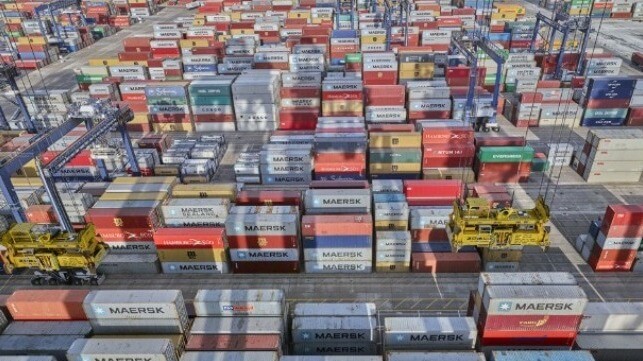Drewry: Surplus of Six Million TEU Built Up by Carriers Will Recede

As the surge in container shipping grew in 2020 and 2021 carriers around the world were scrambling to find enough boxes to accommodate shipments while container manufacturers ramped up production to record levels. A new market analysis by the research and consulting service Drewey points to a near-term surplus of containers, a position supported by many ports that are complaining that their yards are being used to store boxes.
According to Drewry’s recently published Container Census & Leasing Annual Review & Forecast 2022/23 report, the global pool of shipping containers increased by 13 percent to almost 50 million TEU in 2021. That was three times the prior growth trend and in addition, they report that lessors and ocean carriers were retiring fewer aging units in a further effort to rapidly build the supply.
Yet despite the increase in supply, carriers continued to experience bottlenecks throughout the supply chain that meant containers were taking longer to return to the ships and back to manufacturing centers. Drewry in its new report estimated that congestion across global supply chains meant containers were an estimated 15 to 20 percent less productive than in pre-Covid-19 times.
China, which is the largest manufacturer of containers, reported in the fourth quarter of 2020 they had increased container output to 300,000 TEU per month. Chinese container manufacturers had extended their normal working hours from eight hours to 11 hours a day.
As a result, Drewry now estimates that as many as six million TEU of surplus containers exist in the global equipment pool. While large by historic standards, Drewry considers this surplus to be manageable in the longer term for the industry. However, near-term ports continue to complain that boxes are piling up in their yards. In addition to importers being slow to move boxes from the yards, empties have been stacking up.
Drewry forecasts for the equipment market however project that the surplus will begin to decline. They write that output in 2022 and 2023 will be much lower than last year, at 3.9 million TEU this year and 2.4 million TEU next year, with replacement accounting for most of the orders. While they forecast newbuild and second-hand prices will fall, a return to the very low prices of 2019 is not anticipated as manufacturers are expected to manage their capacity and pricing strategies very carefully. Meanwhile, the secondary market remains robust and the uses to which ex-trading containers can be put to use continue to expand.
"Looking ahead, ocean carriers will be the main buyers of equipment over the next two years with lessors then taking control again, raising their share of the pool to 54 percent by 2026," said Drewry’s head of container equipment research John Fossey. "Moreover, per diem rates and investment cash returns will generally be higher over the forecast period than in the past five years."
Drewry also highlights the coming surge in containership deliveries over the next few years as orders are fulfilled from the record pace of containership construction contracts. "The delivery schedule of new ships is very strong with slot capacity expected to increase by 3.6 million TEU in 2023 and by over 3.9 million TEU in 2024," says Fossey.
Also helping to absorb the current surplus capacity, Drewry points to the new IMO emissions regulations coming into force in January 2023 which could result in ships reducing speed to meet the requirements. Finally, after being caught short in 2020 and 2021, Drewry expects that some carriers are likely to expand their buffer stock in their equipment pools in an effort not to repeat the shortages they experienced.
